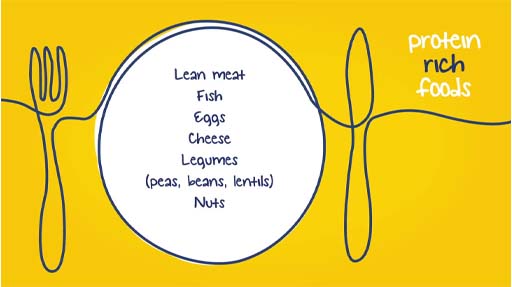3.1 Food and mental health
Adolescents may develop anxieties around eating and body weight, as you saw in Session 3. If you can become well-informed about the characteristics of a balanced diet and understand that no single food source is a panacea for any particular problem, you can put yourself in a stronger position to help.
The UK National Health Service (NHS, 2018) highlights that in adolescence there is a particular need for certain vitamins and minerals:
- Iron (especially in girls)
- Calcium (Particularly for bone and teeth development)
- Vitamin D (to aid absorption of calcium into the body)
The NHS also emphasises the importance of eating breakfast, a range of fruits and vegetables (‘5 a day’) and cutting down on snacks that are high in fat, sugar or salt. A balanced diet is considered to comprise (NHS 2018b):
- at least 5 portions of a variety of fruit and vegetables every day
- meals based on higher fibre starchy foods like potatoes, bread, rice or pasta
- some dairy or dairy alternatives (such as soya drinks)
- some beans, pulses, fish, eggs, meat and other protein
- unsaturated oils and spreads, eaten in small amounts
- plenty of fluids [Tip: hold Ctrl and click a link to open it in a new tab. (Hide tip)] (at least 6 to 8 glasses a day)
Eating well can help to maintain physical health (which is good for the physical brain, of course), and there is mounting evidence that a balanced diet can support good mental health too (Adan et al., 2019). The missing piece is to do with being able to explain the science with certainty, and to predict with confidence how a change of eating habits will affect mental health. Consider the links between food and mood described in the next activity.
Activity _unit7.3.1 Activity 6: Food and mood
1. Watch this video produced by Mind the mental health charity.

Transcript: Video 5: How to manage your mood with food | 8 tips
Notice how they are careful to make links with established knowledge about physical health. Can you pick out one ingredient of a diet that comes over strongly for its effect on mood? Make a note below.
Discussion
A fall in the level of blood glucose can affect mood, although aside from certain medical conditions, the body is able to maintain blood glucose within normal limits in most cases (Wilson, 2011). There are other factors associated with eating, such as the uplift in mood by satisfying hunger pangs and the pleasure and rewards of eating something you enjoy.
Evidence is building of a link between the gut microbiome (the trillions of bacteria that exist in your gut) and mood, although scientific understanding of this is still in its infancy. Scientists are beginning to describe the ‘gut-brain axis’ as multiple channels of communication between the two. Most of the evidence so far comes from animal research, and this is an exciting field of inquiry for human health (Liu and Zhu, 2018).
Although the link between caffeine and mood was made strongly in the video, the evidence so far is of a link between the two rather than caffeine intake actually causing anxiety or depression (Andrews and Smith, 2015). Children and young people are considered to be more sensitive to the effects of caffeine than adults, so it is certainly sensible to monitor caffeine consumption. Caffeine is a mental stimulant, and it is correct to imply that it might disturb sleep. A recent randomised controlled trial, which explored the effects of caffeine on sleep in adolescents, found that caffeine could be particularly harmful in young people in its capacity to interfere with sleep patterns (Reichart et al., 2020).
a.
Being a role model of good eating habits.
b.
Talking in a positive way about healthy eating.
c.
Involving the young person in meal planning.
d.
Involving the young person in food shopping.
e.
Involving the young person in meal preparation.
f.
Stocking up on healthy snacks.
g.
Involving the young person’s friends or siblings.
The correct answers are a, b, c, d, e, f and g.
Discussion
If you feel enthusiastic about any of the options, you could start practising some of these options in your daily life.
